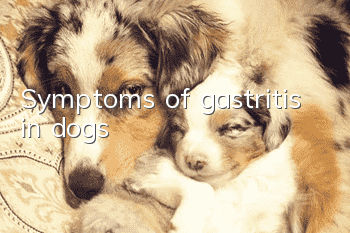Symptoms of gastritis in dogs

Symptoms of dog gastritis
1. Diarrhea is the main symptom of canine gastritis, which can be seen at the beginning of the disease. The feces is liquid and has a foul odor, and in the later stages it is often mixed with mucus, blood, foam, etc.
2. During auscultation of the abdomen, you can hear increased intestinal peristaltic sounds or thunderous sounds, tense abdomen, and curved back.
3. When inflammation spreads to the front of the duodenum or stomach, sick dogs are often accompanied by vomiting.
4. When a sick dog shows symptoms of tenesmus, it means that the inflammation has spread to the colon. When bleeding occurs in the small intestine, the feces will be dark green or black.
5. Sick dogs have mild or moderate fever. If infected with bacteria, the body temperature can be as high as 39-39.5 degrees Celsius.
6. As the disease progresses, sick dogs may show symptoms of dehydration and acidosis.
Treatment of gastritis in dogs
1. Clean the gastrointestinal tract: laxatives (such as sodium sulfate, artificial salt) should be used orally in appropriate amounts.
2. Anti-inflammatory and antidiarrheal: use 0.1 to 0.5 grams of berberine, taken orally 3 times a day. Among the antibiotics, chlortetracycline, oxytetracycline or chloramphenicol can be used.
3. Food stopping therapy: Dogs suffering from gastritis should stop eating for 24 hours and water for 12 hours. Then feed easy-to-digest liquid food, such as warm milk, porridge, vegetable soup, etc. Pay attention to eating small and frequent meals.
4. Excrete poisons: For toxic gastritis, subcutaneously inject 2 to 10 mg of morphine hydrochloride, or take 15 to 60 ml of castor oil orally to promote the excretion of toxic substances.
5. Antiemetic and rehydration: For sick dogs with refractory vomiting, intramuscular injection of 1 mg of chlorpromazine per kilogram of body weight.
6. Antibacterial and Anti-inflammation For gastritis caused by secondary infectious diseases, antibiotics are commonly used for anti-inflammation. Commonly used antibiotics include gentamicin, kanamycin, penicillin, etc.
7. If there are bleeding symptoms, hemostatic measures should be taken. Hemostatic sensitivity can be injected intramuscularly.
8. Antiemetic, metoclopramide, 1~2 mg/kg body weight, intramuscular injection, 2 times/day.
- What to do if your dog is poisoned
- Ways to extend your dog’s lifespan
- How to identify the symptoms of dog poisoning
- Is it necessary for dogs to blow dry after taking a bath?
- Which dog is the smartest and most humane? Dog IQ ranking list
- How to teach a Shar-Pei to urinate and defecate?
- How to bathe a Shiba Inu? What should you pay attention to when taking a bath?
- What are the methods to train a Doberman to bark? There are tricks for training calls
- Why doesn't Teddy dog eat?
- What fruits can dogs eat?



